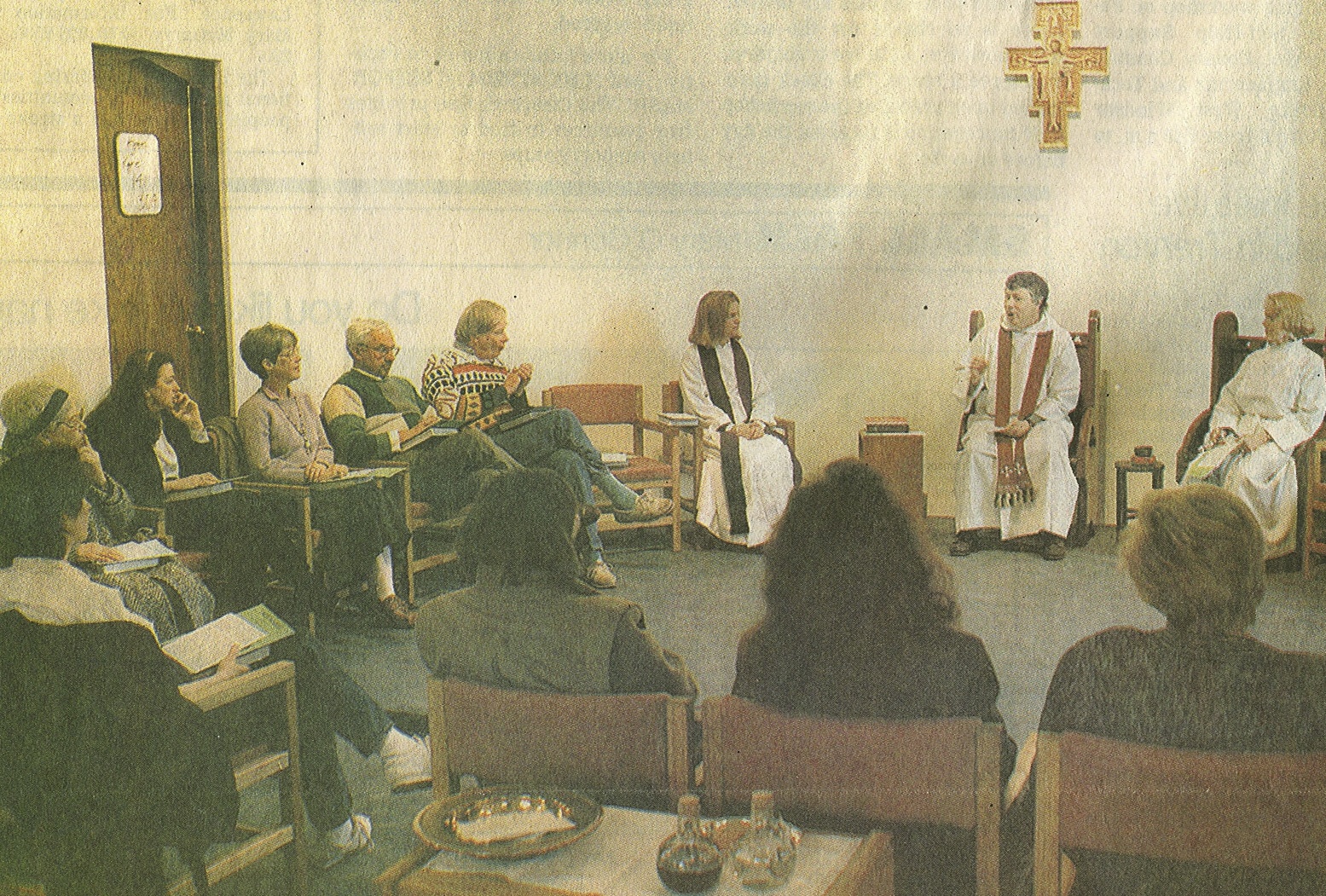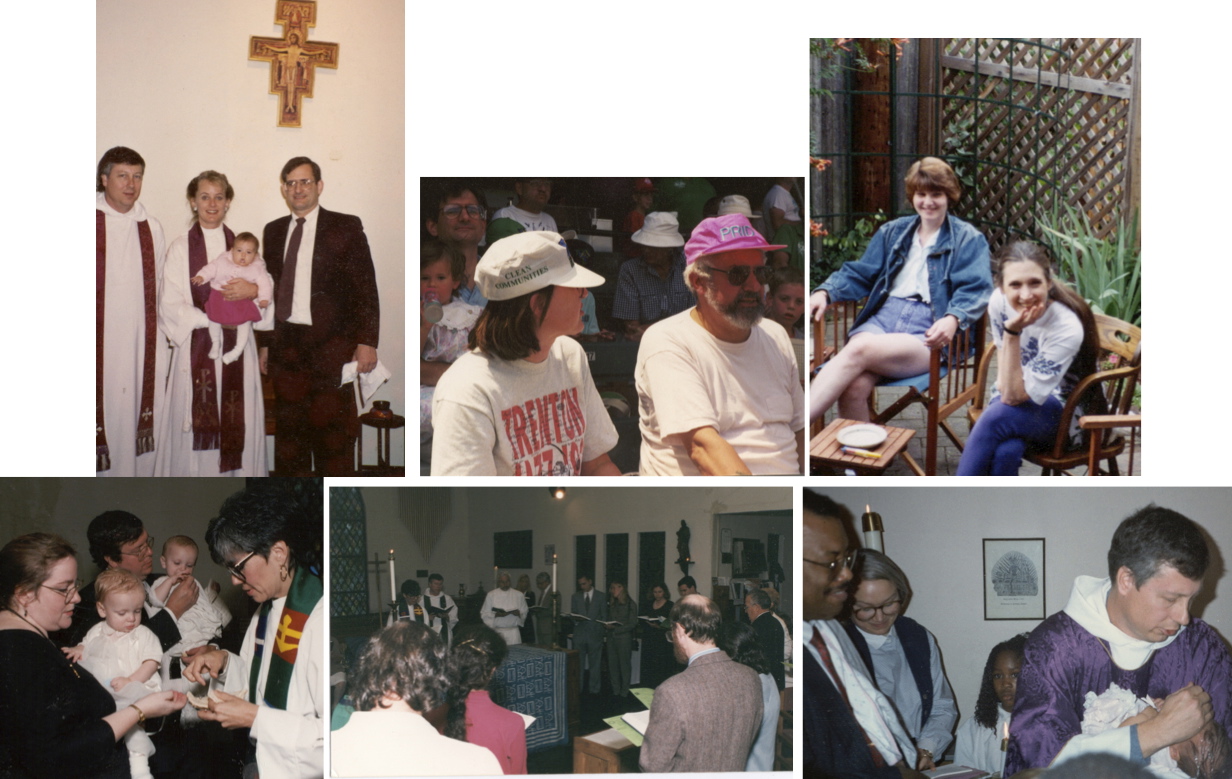The Three Movements of the Spiritual Life: Part Two - From Hostility to Hospitality
The Three Movements of the Spiritual Life
Part One: From Loneliness to Solitude
Part Three: From Illusion to Prayer
Parish life includes this underlying, very visible, though usually unacknowledged dance. It’s a movement from hostility to hospitality. As individuals and as a parish community we move back and forth along that line, moving into generosity and warmth which is then reversed as we give way to moments of antagonism and resentment. And then, again, by grace, we dance toward hospitality.
I was the very part-time vicar of St. Andrew’s, Trenton during the 90’s.[i] Over time that parish developed two distinct congregations. One was an 8:00 am Eucharistic community – a traditional liturgy, Rite One, done in the part of the space where there were still pews. They were white, the descendents of people who came from England 100 years before to work in the pottery factories. They were older (well, younger than I am now but older!).
The other was at 9:30. It took for itself the name The Community of Julian of Norwich—it was a liturgy that began in one part of the church gathered in a circle for readings and a shared sermon, and then moved in a communal liturgical dance around the altar for the Great Thanksgiving. There was incense, lots of silence, occasional jazz masses, along with a common commitment to the arts and the city. The community self-managed[ii] its life with working groups and occasional meetings of the entire community. This congregation was more diverse in some ways than the 8:00—black and white, gay and straight, younger and older.

In that strange and wonderful parish people did find their deepest self and they did find community with one another. It was a foretaste of the kingdom described by John Macquarrie, “The end … would be a commonwealth of free, responsible beings united in love.” In the past couple of years several of them have been in contact to express how that time together shaped their lives. One member wrote years later as she was affirming her participation in another Episcopal parish church, “I have always dreamed of one day finding myself in a community like that of St. Andrew's. Our God is an amazing God who joys in fulfilling our deepest wishes for ourselves. Because these wishes will always result in our being and becoming within Christian community, a baptized community of the beloved, who are blessed, called and empowered to serve countless others in a broken world.”[iii]
The pathway into that life came by way of what Nouwen is getting at when he writes of the need for both receptivity and confrontation.
Receptivity without confrontation leads to a bland neutrality that serves nobody. Confrontation without receptivity leads to an oppressive aggression which hurts everybody.
Scene One - Margaret had been in the parish for several months. We began to learn that she was something of a fundamentalist. It would come out during the shared sermon times and at coffee hour.
One day before Mass she came up to me. She wanted me to speak with Edd and Alan. She was disturbed by their behavior. They often held hands during the liturgy and on occasion at the Peace would exchange a kiss. She wasn’t against gay people being in the parish but she didn’t want to have to see them expressing it in public.
I listened, asked a few questions, and said something along the lines of, “I’m glad you’re part of the parish, Margaret. And I don’t think I’ll be saying anything about this to Edd and Alan.” So, I didn’t do anything about that.
Scene Two - Edd and Alan would attend the 8:00 Mass when they were taking a trip on Sunday. In that congregation people did not exchange the Kiss of Peace with any physical contact—no handshaking, and certainly no hugging. The reverse was true at 9:30.
After a couple of times at the 8:00 mass Edd and Alan came to me and wanted me to do something—“there should be at least handshaking.” In fact why didn’t we have coffee hour between the two liturgies so the 8:00 people could get to know the 9:00 people? Maybe they would find themselves coming to 9:30 instead of continuing in this cold, distant behavior.
I didn’t do anything about that either.
Scene Three - One Sunday at 8:00 Edd and Alan were present; they were going to the beach for the day. A Black woman came in. There had never been a Black person at 8:00 in my memory. After mass she told the group that she was in town to care for her sister, now in St. Francis Hospital for surgery.
As we came to the Peace I said the usually words, “May the Peace of the Lord be always with you.” And the congregation responded, “And also with you.” And then the visiting African American woman reached out her hand to Jane—at which point all movement in heaven and earth ceased. And then, after just the slightest hesitation, Jane reached back, taking the woman’s hand and enfolding it with her left hand. And then everyone exchanged the Peace with handshakes.
Receptivity without confrontation leads to a bland neutrality that serves nobody. Confrontation without receptivity leads to an oppressive aggression which hurts everybody.
The 8 o'clock community never again exchanged the peace in a physical way.
It wasn’t the touching that mattered; in itself that’s not more hospitable and more open. It was the willingness to go beyond what was comfortable; to not go into a place of hostility because their routine was being disrupted, but in that moment be generous and receptive, accepting and kind. An act of sensitivity and openness toward the stranger.
It was a small movement toward hospitality; a movement of choosing hospitality over hostility.
Margaret who so much wanted Edd and Alan to be different finally left the parish seeking another place. Later I learned that we had been the eighth parish in the region she had tried out.
The free and open space we seek is not bland neutrality or oppressive aggression; rather it is openness and boundaries, acceptance and challenge, receptivity and confrontation. God brings us to fullness of life by a mixture of grace and judgment.
 I have been the trainer in many workshops using a lab education method of learning. The process in lab learning is one of learning from the experience of the individual and the group. The methods used are feedback about the impact of your behavior on others and a disciplined reflection on experience. We mix in a bit of theory and some coaching by the trainers.
I have been the trainer in many workshops using a lab education method of learning. The process in lab learning is one of learning from the experience of the individual and the group. The methods used are feedback about the impact of your behavior on others and a disciplined reflection on experience. We mix in a bit of theory and some coaching by the trainers.
One of the theories sometimes used as a lens to help participants see patterns in the group is Will Schutz’s I-C-O Group Development Model.[iv] Among the issues all groups live with are inclusion, control, and openness.
Here’s one way of understanding the model. The movement is from bottom to top (start with inclusion).
|
Issue |
|
Am I? |
|
Group Development |
|
Underlying feeling |
|
Fears |
|
Openness |
|
Open/Closed |
|
How open will I be? How close can I get? |
|
Likeability, lovability |
|
Being rejected. Being unlikable, unlovable |
|
|
|
|
|
|
|
|
|
|
|
Control |
|
Top/Bottom |
|
How much influence, power and responsibility will I have? Issues of leadership and decision-making processes. |
|
Competence |
|
Being humiliated, embarrassed. Being incompetent, phony |
|
|
|
|
|
|
|
|
|
|
|
Inclusion |
|
In/Out |
|
Inclusion compatibility is central in the early stage. How will I fit in this group? |
|
Significance |
|
Being ignored. Being insignificant, worthless |
Adequate resolution of an issue allows the group to attend to the next stage up. Note, the word is “adequate” not “compete” or “perfect.” To the extent inclusion is addressed that allows a certain degree of the control issue to be addressed. As inclusion grows the group’s capacity for handling control grows. To the extent there is resolution the group may move to deal effectively with the next stage up issues. Resolutions are all temporary.
I assume you see the relationship between the work of Nouwen and Schultz, especially in regard to how inclusion issues are connected with loneliness and solitude.
What I’ve noticed again and again is that expressions of hostility in labs, especially early in the experience, seem rooted in the person’s own loneliness and difficulty with solitude. Often the person can’t acknowledge, and may not even see, their hostility as hostility.
When explored what sometimes comes to the surface is anger and blame. At times it is set-off by having been required to attend the program. In almost all cases there is an unwillingness to accept the culture of the learning group. Frequently there is a history to the stance; the person has experienced something familiar to this again and again. They often remain convinced that the experience is grounded not in themselves but in the ways of others.
Early attempts to influence, another word for “control” in this context, the direction and ways of doing things may be made. In my experience they never get anywhere. I’ve never seen a time when the training staff had to protect the lab way of doing things; the group took care of it. The participant was jumping to an attempt to control things before there was an adequate degree of resolution to the inclusion issue.
Groups with a reasonable amount of emotional intelligence usually ignore the attempt at control and any overt hostility that comes along with it. The attempt is greeted with a lack of response. In time what usually cuts through things is either a series of self disclosures in which people end up introducing themselves to the group with a mix of appropriate emotional openness and stories about what they have left behind in order to be present this week or someone boldly entering into the experience by requesting feedback on what people have experienced of them in just the first part of the workshop. Which is to say that what happens that “works” is something that fits the workshop’s culture, the lab’s way of being and doing things.
It’s the same in all parishes, groups and organizations. They all have ways of being and doing; ways in which people get to include themselves and exercise influence. They all have ways that will “work” to move toward hospitality and away from hostility.
Hostility brings with it a kind of blindness. The person or group misses their own desire for unity and experience of alienation; they don’t see the actual choices in front of them. They lack a sense of awe and wonder; they can’t acknowledge their feelings of lostness, loneliness and hostility; and they are unable to be still and silent in a gentle and reflective manner. Instead they get caught up blaming and anger, in resentments and fear. Their intellect, which may be considerable, is used in the service of defense and separation rather than figuring out how in this particular setting they might include themselves in this specific human community.
And then, sometimes it happens, with hesitation or confidence, the person steps into the dance. It may be graceful or awkward but there they are doing a new thing. They have heard and seen something that draws them forward into the place of communion.
The free and open space we seek is not bland neutrality or oppressive aggression; rather it is openness and boundaries, acceptance and challenge, receptivity and confrontation. God brings us to fullness of life by a mixture of grace and judgment.
rag+
A handout on the movement from hostility to hospitality

[i] It’s now a Nigerian parish in the Diocese of NJ. Back then I was a Sunday plus vicar making my living by consulting with non-profit groups: affordable housing, social services, women’s shelters, performing arts.
[ii] As in almost all organizations using self-management structures the degree and form of self-management was interdependent with accountability to the traditions and norms of the wider church, focused in the vicar, and responsiveness to the vision and culture of the congregation, as focused in congregational meetings.
[iii] Nanette Woodworth also wrote, “I completed my degree at Union Theological Seminary in 1998, …That was a fruitful spring! I became a member of the Community of Julian of Norwich at St. Andrew's Episcopal Church in 1993. This was something that surprised everyone in my family! However, I found something at St. Andrew's that I needed at this very demanding time of my life...a small church community that did not ask more from me than I could give; a focus on the spirituality of Julian; inclusive language; alternative jazz worship; a diverse community that reflected my urban seminary community; and a deep sense of church as family with respect for the individuality of each brother and sister.”
[iv] The earlier version of the theory was I-C-A” Inclusion, Control, Affection. The FIRO B instrument is based on that model. For related articles. Also an paper “My Teammates are Driving Me Crazy"